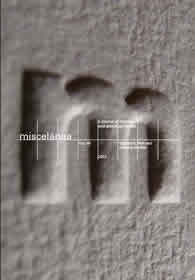La traición Edénica en la literatura artúrica: Consideraciones sobre la identidad de la pareja en La morte d'Arthur de Thomas Malory
DOI:
https://doi.org/10.26754/ojs_misc/mj.20128944Palabras clave:
Traición, Conocimiento, Conducta, Norma, CrimenResumen
La tradición cristiana mitifica la primera gran traición de la genealogía humana: el episodio de Eva y la manzana en el Jardín del Edén. La mujer, ansiando el conocimiento supremo que la sitúe al mismo nivel del Creador, infringe la norma establecida por este y viola el lazo casi sagrado de la confianza depositada en ella. Mas la pedagogía social basada en la exégesis bíblica no es la única corriente interesada en el poder ejemplarizante de la traición y el consiguiente castigo ritual como mecanismo catártico. En el terreno de la mitología pagana son numerosos los casos en que un personaje —normalmente un cargo preeminente— es acusado de felonía, debiendo someterse al escarnio público. Generalmente, siguiendo el patrón del Génesis, se trata de figuras femeninas movidas por la ambición, la avaricia o el deseo. Tal es el caso de la reina Ginebra, el hada Morgana o Vivien, todas ellas pertenecientes a los ciclos legendarios artúricos. El caso de esta última es especialmente interesante por la notable simetría entre la relación que establece con su álter ego masculino, Merlín, en la búsqueda de la sabiduría y el mito judeocristiano de Eva y Adán. Tomando como referencia la caracterización que Thomas Malory establece en Le Morte Darthur, pretendo realizar un análisis intertextual que profundice no solo en los evidentes paralelismos, sino también relación entre la mujer, la búsqueda del conocimiento y la noción de traición.Descargas
Referencias
AUERBACH, Nina. 1980. “The Rise and the Fallen Woman”. Nineteenth-Century Fiction. 35:1 (junio): 29-52.
BAINES, Keith. 2003. The Works of Thomas Malory. Londres: Penguin Books.
BOILÈVE-GUERLET, Annick. 1995. “D’une sculpture de la cathédrale de Santiago à María de Zayas, évolution du motif de la femme adultère et de la tête coupée” Figueroa, A. y J. Lago (coord.) Estudios en homenaxe ás profesoras Françoise Jourdan Pons e Isolina Sánchez Regueira. Santiago de Compostela: Servicio de Publicacións e Intercambio Científico U.S.C.: 345-357.
BORGES, Jorge Luis. 1974. The Book of Imaginary Beings. Londres: Penguin Books.
BOURDIEU, Pierre. 1991. “Le champ littéraire”. Actes de la Recherche en Sciences Sociales 89: 4-46.
FOUCAULT, Michel. 1975. Surveiller et punir. Naissance de la prison. Paris: Gallimard.
HAIGHT, Gordon S. 1947. “Tennyson’s Merlin”. Studies in Philology 44: 3, (Julio): 549-566.
HOLBROOK, S.E. 1978. “Nymue, the chief Lady of the Lake, in Malory’s Le Morte Darthur”. Speculum 53: 4 (octubre): 761-777.
MALORY, Thomas. 1969. Le Morte Darthur. 2 Vol. Londres: Penguin Books.
VINAVER, Eugène. 1990. “Caxton’s preface”. En Vinaver, Eugène (ed.) The works of Sir Thomas Malory. T. 1, Oxford: Clarendon Press: xiii-xv.
Descargas
Publicado
Número
Sección
Licencia
Derechos de autor 2013 Almudena Gómez Seoane

Esta obra está bajo una licencia internacional Creative Commons Atribución-NoComercial 4.0.


